13 El laberinto del fauno Dir. Guillermo del Toro, 2006
 Uno de los films en español de más éxito mundial es El laberinto del fauno, dirigido por el mexicano Guillermo del Toro. Aunque muchos piensan que la acción toma lugar durante la guerra, la acción se sitúa en 1944, 5 años después de que la guerra hubiera terminada oficialmente. Pero como ya hemos visto, en 1939 la guerra terminó solo oficialmente, durante la dictadura, persiguieron a miles de españoles por no estar de acuerdo con Franco.
Uno de los films en español de más éxito mundial es El laberinto del fauno, dirigido por el mexicano Guillermo del Toro. Aunque muchos piensan que la acción toma lugar durante la guerra, la acción se sitúa en 1944, 5 años después de que la guerra hubiera terminada oficialmente. Pero como ya hemos visto, en 1939 la guerra terminó solo oficialmente, durante la dictadura, persiguieron a miles de españoles por no estar de acuerdo con Franco.
Cuando terminó la Guerra Civil, algunos no aceptaron la derrota y continuaron la lucha armada. Como no podían avanzar con una lucha directa, los maquis vivían escondidos en bosques, eran guerrillas que bajaban para atacar a los fuerzas franquistas cuando vieran una oportunidad. Los maquis eran perseguidos con especial ferocidad por el ejército y la guardia civil. Como mucha gente, los maquis esperaban que cuando Hitler y Mussolini perdieran la Segunda Guerra Mundial, que entonces el régimen franquista también caería.
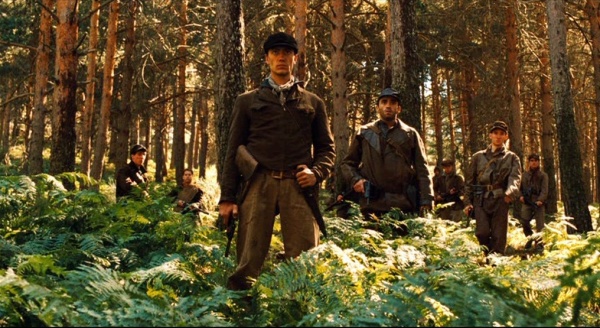
La Guerra Civil
Un elemento curioso sobre El Laberinto del Fauno es que ha tenido éxito entre públicos que desconocen por completo la historia de España y de la Guerra Civil. Uno de los grandes logros de del Toro con El laberinto del fauno es que consigue ser una película española para una parte de su público, y una película de guerra para los demás.
¿Cómo consigue este balance?
Del Toro forja una conexión con su público ilustrando su narración con imágenes que les son familiares a casi todos.
- El malo de la película — todos han visto películas de nazis. La figura del Nazi malvado es un tópico del cine que
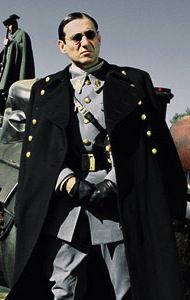
El Capitán Vidal, presentado según el modelo típico de los Nazis de las películas sobre la Segunda Guerra Mundial todos conocen. Vidal es capitán del ejército español, pero está configurado como el típico Nazi de las películas sobre la Segunda Guerra Mundial.
- La literatura infantil — En la primera escena de la película en que conocemos a la
 protagonista Ofelia, ella está leyendo un libro de cuentos de hadas. Su madre le regaña por traer tantos libros, pero para Ofelia, los libros son vitales. Ofelia se escapa de su realidad cruel por medio de sus libros. La Estética del film hace tributo a algunos de los gran ilustradores de libros infantiles. Por ejemplo, el vestido de Ofelia, que su madre le prepara especialmente para la cena del Capitán Vidal, es un tributo a las imágenes más conocidas de Alicia en el País de la Maravillas. La principal diferencia con el vestido de Ofelia es que es verde.
protagonista Ofelia, ella está leyendo un libro de cuentos de hadas. Su madre le regaña por traer tantos libros, pero para Ofelia, los libros son vitales. Ofelia se escapa de su realidad cruel por medio de sus libros. La Estética del film hace tributo a algunos de los gran ilustradores de libros infantiles. Por ejemplo, el vestido de Ofelia, que su madre le prepara especialmente para la cena del Capitán Vidal, es un tributo a las imágenes más conocidas de Alicia en el País de la Maravillas. La principal diferencia con el vestido de Ofelia es que es verde.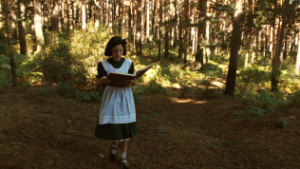
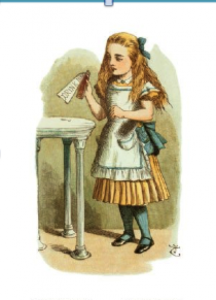

Para las escenas en el bosque encantado, del Toro también hace referencia a las ilustraciones de cuentos infan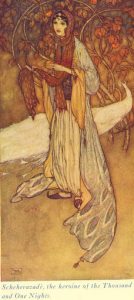 tiles. El ilustrador Kay Nielsen es una de las inspiraciones. Y también Edmund Dulac le inspira, especialmente en las escenas finales cuando Ofelia desciende a estar con sus padres en una escena permeada de rojos y dorados. Dulac es especialmente reconocido por sus ilustraciones de las Mil y una noches.
tiles. El ilustrador Kay Nielsen es una de las inspiraciones. Y también Edmund Dulac le inspira, especialmente en las escenas finales cuando Ofelia desciende a estar con sus padres en una escena permeada de rojos y dorados. Dulac es especialmente reconocido por sus ilustraciones de las Mil y una noches.

Lean la conferencia que la Profesora Soliño presentó en el “European Film Conference” en San Antonio el 8 de febrero, 2008.
Paper read at the “European Film Conference” at the University of Texas, San Antonio, Sept. 8, 2008
María Elena Soliño
In the early 1940s, as Spanish cinema tried to reconstruct the industry after the devastation of the Civil War, the image of children we find in the early films is, as Josep Estivill says, “el elogio de las virtudes infantiles que predisponía a los niños a imitar las gestas heroicas de los mayores.” (23) In what is perhaps one of the most famous examples, the good boy of the Churruca family, a metaphorical Francisco Franco, in Raza yearns from a young age to imitate the military heroism of his father. “El futuro héroe franquista, aparece ya durante la etapa infantil como un niño amante del riesgo y el sufrimiento.” (23) At times there is very little that differentiates the ideology of the adult warrior from that of the child as children are routinely pictured receiving military instruction and parading in uniform with a practice rifle over their shoulder, as in the end of Romancero marroquí. However, Spanish film of the 40s produced no notable child protagonists, the children are undifferntiated threads in the social fabric.
Although there had been child stars in Spanish film before –Pitusín (1924) from the silent era and Arturito Girelli (1935) and Mari-Tere during the Second Republic – , as Román Gubern points out, “En los años cincuenta este filón renació con mucha fuerza, con un vigor que nunca había manifestado antes en nuestra producción…” (10) The trend was set in motion in part by the grand success of Italian films such as the 1951 Pepino y Violeta, a Franco-Italian co-production about a boy from Asís and his donkey. And then in 1955 Ladislao Vajda directed what is one of my most-watched Spanish films of all times, Marcelino pan y vino. Even a quick glance at the scant research devoted to Marcelino pan y vino turns up repeated uses of the label “película emblemática de la cinematografía española.” With its enormous success, Marcelino established a home-grown genre commonly referred to as “cine con niño.” (11) Marcelino is the story of a baby that is left at the doorstep of a monastary, where the boy is raised by 12 friars. After meeting a beautiful mother while out playing, Marcelino begins to long for a mother of his own. Based on a series of medieval miracle poems, the child forms a friendship with a statue of Christ stored in the attic. In recompense for bringing him daily bread and wine, the Christ figure offers the child the fulfillment of a wish. Marcelino asks to be reunited with his mother. He dies in order to be reunited with her in heaven. Yet, viewers and critics often ignore the frame within which this story is told. The tale is related by a friar who visits the home of a dieing child as a way to confort both her and her parents through the assurance that death has no finality, and that the child will be happy in heaven, as was Marcelino. Along with this religious lesson, the frame also has a historical referenent that at first glance my seem peculiar. The action is situated in the aftermath of the Napoleonic invasion. In this not so subtle voiceover, the narrator assures the public that if Spain was able to rebuild after that war, they can do it again after the more recent battles. Marcelino is not the only one who will resurrect, so will the nation. And thus we see one key feature of the cine de niño, the reassurance, and in later films the negation, that the nation has suffered any trauma.
Marcelino, starring Pablito Calvo ushered in a new era of child stars, the most famous of which are obviously Joselito and Marisol. Although those who love Spanish film may consider it a heresy to utter the names of Joselito and Marisol in the same sentence as The Spirit of the Beehive and Pan’s Labyrinth, I believe that it is useful to consider the latter as a sort of reaction and correction to the image of Spanish childhood presented by the former. In some way or another, all react to the question ¿How do children process fear, and how does society as a whole react to their children’s fears?
In the case of Joselito and Marisol, they sing them away as happy children smiling through adversity. When interviewed by Augusto Torres in 1973, Pedro Masó, who produced some of the greatest commercial hits of the 1960s explained that the attitude of many towards film was, “Muy clara y sencilla: hacer películas para todo el público, que es para quien trabajamos los que hacemos cine, que lo pase bien evitándole problemas profundos, no porque no sepamos sino porque ya tiene bastantes todos los días.” (144) In 1956 director Antonio del Amo presented the first film starring Joselito El pequeño ruiseñor. Most of the Joselito gentre follows the succesful pattern of the españolada in which a gifted character of humble origen, possessing both a voice and a heart of gold, overcomes adversity to become famous, not only in his own country, but across the ocean, in the American market. In the case of El pequeño ruiseñor, as with the adult stars of the españolada, the desire for fame is unselfish. They want success in order to restore harmony to their families or towns. Joselito tours America to gather funds for an operation that will restore the sight of his blind friend. Lest the public mistakingly think that American medicine is superior to the Spanish brand, the girl is cured in his absence and the trip serves mainly to prove his pure intentions. But, the American episodes also help the Joselito films connect to a wide audience in America where they were huge box office hits, remaining so even today in the DVD and late-night television movie market.
Joselito’s success is only comparable to that of Marisol, who was discovered in 1959 by Manuel Goyanes. Since she was already on the cusp of adolescence when she was discovered, her career as a child star only spans 4 films, although she went on to make many more. In keeping with the spirit of the Francoist era dictates that demanded that film, especially those that could be seen by the young, exalt family values and contain moral lessons, in films such as Un rayo de luz and Ha llegado un ángel, the character played by Marisol is manically cheerful, and the Sección femenina de la Falange taught girls that cheerfulness was a vital trait in a girl, and brings about reconciliation in troubled families.
In her groundbreaking book, Blood Cinema, Marsha Kinder explains that in filmic family melodramas, the problems of the individual family mirror those of the nation. Although they may not be brought to the forefront, even the films of Joselito and Marisol reflect a society of broken families and towns, where children suffer privations and loss. The new generation of child stars do not appear traumatized by a war that affected every Spanish family. Instead, the shots of of the singing, reconciliatory child protagonist conditions the gaze of the audience to believe in the happy future that at heart everyone desires. The world seen through the eyes of Marisol and Joselito, artificially twinkles with filtered glee. The fear a normal child would feel when faced with disease, economic hardship, the loss of one or more parents, and the rejection by one’s family, is simply sung away.
In contrast to these musical versions of childhood, Sánchez-Biosca states that, “Es muy posible que El espíritu de la Colmena sea la película más silenciosa del cine español.” (275) The use of a child protagonist in this film provides an original outlet of expression for ideas long suppressed and that could best be discussed in oblique ways. After more than a decade of cinematic production that aimed to assure moviegoers that the future of the nation was secure, since it had produced a generation of happy songbirds such as Joselito and Marisol, instead of a nation of traumatized youth, directors such as Erice began to use children in their films to rectify this fictional portrayal and replace it with the visions of a reality filtered through the nightmarish realities that often define childhood, especially in times as difficult as the Spanish postwar. Ana Torrent’s dark, continuously tortured and questioning eyes dominate the film. In my argument, the point of view of the film is defined not only by what the child protagonist sees, but also by images of a world that have failed her. Ana is abandoned in a landscape that is not only visually barren, but also devoid of human connection since she is being raised by people so locked into their own suffering, that they cannot see hers. When Ana asks her sister Isabel to explain the film Frankenstein to her, especially why the monster kills the girl to then in turn be killed himself, Isabel responds that neither dies, “Porque en el cine todo es mentira, es un truco.” But in the Spain of the early 40s and even into the early 70s, was film any more of a lie, or a trick, than the official discourse?
One of the most successful Spanish films in recent years, and that is intimately tied to The Spirit of the Beehive, has been Mexican director Guillermo del Toro’s Pan’s Labyrinth in which the horrific landscape of post-war Spain is presented through fantastic and nightmarish scenes filtered through the child protagonist’s imagination and inspired by Ofelia’s beloved book of fairy tales. Thus, the audience comes to understand the repression that gripped the fascist Spain of the forties, all told through the eyes of a child who can grasp complex truths with greater acumen than that of the adults that surround her.
In February of last year, at the Sixth Annual Cine-Lit Conference, at a round-table discussion of the present state of Spanish cinema, one of Spain’s most renown critics, Santos Zunzúñegui, along with his colleagues, placed Pan”s Labyrinth on their list of the four most important Spanish films of 2006, yet criticized it strongly for its crude division of the world into good and evil, “grosero manequeísmo” and dismissively labeled it the “freaky remake of The Spirit of the Beehive for the Lord of the Rings generation” Del Toro himself is the first to acknowledge the connections between the two films. In an interview with Borja Hermoso during the Cannes Film Festival he said, “Victor Erice ruined my life with The Spirit of the Beehive, because it left me thinking that I will never amount to anything other than Erice’s dumb son (el hijo tonto are his exact words).” He credits Erice with teaching him to “contar en oblicuo” to tell a story obliquely.
One of the many ways that del Toro achieves this oblique vision of post-war militaristic Spain is through a series of intertextual references from
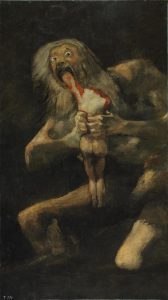
the genres of painting, illustration, and fairy tales. By combining these classic references with the most sophisticated techniques in makeup, costuming, and special effects, del Toro creates a gripping tale that is more in line with the film audiences of the twenty-first century accustomed to works such as The Lord of the Rings cycle, directed by Peter Jackson. What Zunzúñegui mistakenly calls “grossly Manichean techniques” may be partly inspired by the fact that del Toro was inspired to tackle the subject of the Spanish civil war and its aftereffects by a number of Spanish exiles in the Mexican film community, chief among them Emilio García Riera who defined the Spanish tragedy as “the last just was of the twentieth century” to the then budding filmmaker who would have obviously noticed the striking contrast between the nighmarish vision of Spain from the exiles and the whitewashed reality of the Joselito and Marisol films that had flooded the Latin American market. But more than anything, Del Toro offers a continuation of well-known artists that had long ago redefined how war and its aftermath was portrayed in the arts. He tells El Mundo that “The clash of fantasy and reality produces thought” in clear reference to Goya whose painting Saturn Devouring His Own Children he had previously cited as an intertext.
To highlight this defining clash of fantasy and reality, Del Toro offers a film that deviates strongly from the realist format customarily expected nowadays in the portrayal of the aftermath of the Civil War, and enters into the world of fairy tales, strictly following all the conventions of that artistic genres, except, as we shall see, one of the rules. But this is far from the Marisol-type Cinderella story of familial reconciliation, and there is no Joselito to play the knight in shining armor.
The film begins with panned shots of the architectural ruins created by the recent military combat with the caption 1944: Fifth Year of Peace superimposed upon the images that contradict the official Francoist rhetoric. This monstrous contradiction reverberates throughout in the phantasmagoric subterranean world Ofelia will visit during moments i in the film when politically charged actions are occurring above ground on the realistic plane. pause to show the scene of the banquet as commentary of how the nation is starving the people while the elite feast.
The duality of Ofelia’s vision of a traumatized Spain is established almost immediately in the first encounter between Ofelia and her new stepfather, Vidal when as she descends from the car, the girl responds to his handshake with her left hand. She doesn’t care when Vidal scolds her sternly, because in her right hand she holds the keys to her salvation, the story books that offer a vision of the world that perhaps is more real than the apparent reality at the old mill, that has now been converted into a military base. From the very beginning, the child character has a better understanding of certain issues than the adults who surround her. Ofelia realizes that Mercedes helps the Maquis long before anyone else.
The story books that Ofelia refuses to put down to shake the hand of her oppressor, who she thus publicly rejects as a new father, and her actions towards them, come to symbolize the spirit of anti-fascist resistance that will triumph at the end of the film. Del Toro himself describes the film as “an anti-fascist fairy tale set in post-war Spain.” In the same anti-conventional line, del Toro celebrates the role of women in the Resistance. He tells reporters that “women are the most evolved form of humanity” adding that “fascism is a masculine thing. There is a tenuous but very potent solidarity among women.”
Accordingly, there is a systematic subversion of the gender roles presented in the traditional canon of fairy tales, and that are meant to indoctrinate girls into the roles conventionally assigned to women in society. To begin, instead of the expected evil stepmother, we have a stepFATHER, whose extreme levels of cruelty meet or exceed the standards for stepmotherly cruelty established by the Brothers Grimm, even at the level of inflicting physical mutilations, both those he inflicts and receives. One key moment in the film is when Ofelia is presented with a new dress to wear to the official dinner Vidal is hosting for the local dignitaries, whom he hopes to impress with his new family. Her mother tells 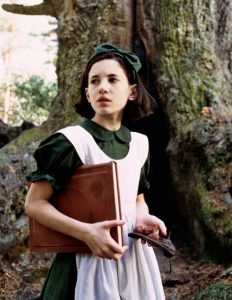 her “You will look like a princess.” Except for that it is green, Ofelia’s dress is recognizable as a copy of the one worn by Alice in Wonderland. Del Toro himself states that it is a direct imitation of the one drawn by Arthur Rackman, which would later be copied by Disney for its version. But note the difference in the colors. The increased unnaturalness in the Disney version highlights how unnatural the modes of female comportment taught through the literary fairy tales really are. The relationship that Ofelia establishes with her new dress makes clear that she rejects the view of herself as a helpless little fairy tale princess being saved by this supposedly wonderful new man. Instead, more than a princess, Ofelia becomes the hero of her own story, destroying the outward signs of codified femininity in the process.
her “You will look like a princess.” Except for that it is green, Ofelia’s dress is recognizable as a copy of the one worn by Alice in Wonderland. Del Toro himself states that it is a direct imitation of the one drawn by Arthur Rackman, which would later be copied by Disney for its version. But note the difference in the colors. The increased unnaturalness in the Disney version highlights how unnatural the modes of female comportment taught through the literary fairy tales really are. The relationship that Ofelia establishes with her new dress makes clear that she rejects the view of herself as a helpless little fairy tale princess being saved by this supposedly wonderful new man. Instead, more than a princess, Ofelia becomes the hero of her own story, destroying the outward signs of codified femininity in the process.
What we find in Pan’s Labyrinth is precisely a narrative formed by the “quest motif” exactly as it is framed by Joseph Campbell, in which in order to be worthy of the title “hero”, the hero must perform a certain number of dangerous and difficult tasks.
Campbell’s Quest Motif
- The hero is both universal and unique.
- Destiny — The hero’s destiny is revealed — a quest is initiated. The hero may be reluctant to go.
- Wise Old Man/Woman — The hero is given a charm, aid or advice by someone older or wiser.
- Foes — The hero makes allies and enemies. He will be tested to prove his worth.
- Foes — The hero makes allies and enemies. He will be tested to prove his worth.
- Romance — The hero finds romance, but this may be a hindrance or a distraction from his quest. (not in this movie)
- Final Battle — The climax of the hero’s journey comes in the form of a final battle or showdown.
- Journey Home — Once the hero has achieved his goal, he must return home. This journey is often difficult.
Two types of hero deeds:
1. The physical deed, i.e. saving life, sacrificing self. Spiritual deed. Has experienced, learned or found way to experience, super normal range of human spiritual life and has come back and communicated it.
2. The hero deed is a cycle, death and a rebirth, this is the basic motif of the hero journey.
Typical examples: Ulysses, Prometheus, Moses, Prince Valient
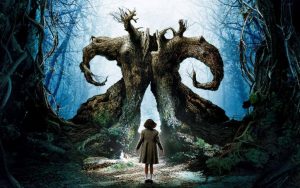
 |
Like Campbell’s traditional hero, Ofelia must accomplish three nearly impossible tasks, helped by a magic being, in this case the Faun, within a limit of time, here before the full moon.
That the character is named Ofelia should not detract from the heroic feminine aspects of the work, since as scholars such as Sharon Keefe
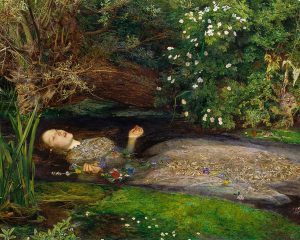
Ugalde have shown in studies on Spanish women poets, “Many contemporary women poets of Spain find Ophelia an optimal text for practising a stance of ‘resisting reader’. Authors read Ophelia and then proceed to re-create her, a construction that contains a map of misreading previous Ophelias.” These are re-writings that also incorporate resurrections of a pliant body that has inspired so many graphic images. I again cite Keefe Ugalde, “From the watery death arises an alternative vision for humanity, one which is permeable to the Other and accommodates non-rational forces associated with the semiotic, the feminine and nature.”
Many have seem Ofelia’s physical death at the end of Del Toro’s film as a failure of this odyssey, but I believe that this readings is too firmly anchored in the plane of reality of the film, as well as knowledge of the actual Spanish state of the forties. Instead, del Toro establishes a direct conection between the earthly death of the child in the film at the hands of fascism, but her continued subterranean existence, in fact triumph, with another version of Spanish history from that time. According to the director, “Reality is brutal and it will kill you, make no mistake about it, but our tales, our creatures and our heroes have a chance to live longer than any of us. Franco suffocated Spain for decades as he tried to fashion it after what he believed to be ‘good for her.’ Yet Spain didn’t die; she exploded, vibrant and alive, in the 80s. Spain lived the 60s in the 80s and they are still feeling the aftershocks of such a wonderful explosion.”
In 2003, at a presentation of the tenth-anniversary re-issue of the The Spirit of the Beehive on dvd, Ana Torrent, it’s child-star, described the film as the “Discovery of a reality and a world. I think that The Spirit of the Beehive speaks of childhood and the places it holds in the discovery of the world, and what roles fantasy and imagination play in that discovery.” With his Ofelia, Guillermo del Toro has created a descendent worthy of 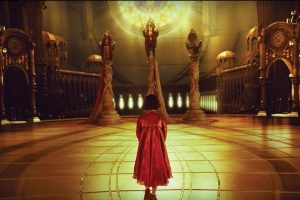 continuing Erice’s tradition of painful discoveries, not only at a personal, but also at a national level. For del Toro, the main sin of fascism is that it annihilated the individual who is compelled to obey blindly. Princess Ofelia recovers her kingdoms when she passes the last trial – she refuses the Faun’s orders to sacrifice her infant brother. The day the majority of men exhibit the valor of this little girl, we may indeed arrive at a heroic society.
continuing Erice’s tradition of painful discoveries, not only at a personal, but also at a national level. For del Toro, the main sin of fascism is that it annihilated the individual who is compelled to obey blindly. Princess Ofelia recovers her kingdoms when she passes the last trial – she refuses the Faun’s orders to sacrifice her infant brother. The day the majority of men exhibit the valor of this little girl, we may indeed arrive at a heroic society.

